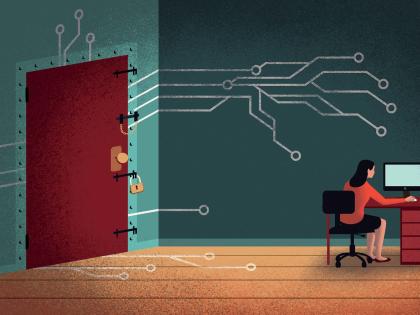“I coulda’ been a contender,” erupts Marlon Brando, as the former boxer and dispirited dockworker Terry, in the iconic scene from On the Waterfront. “I coulda’ been somebody. Instead of a bum, which is what I am—let’s face it.” Terry is unloading his anguish on his brother Charley, the key figure in his undoing, played by Rod Steiger. It makes for great drama: two siblings wrestling with regret, accusation, and a life-altering mistake that still haunts them both.
That’s how it happens in the movies. In fact, such film scenes may have helped persuade us that we all act this way, sharing our feelings about the most important aspects of our lives with the few people we know best: family, lovers, close friends. Yet recent research on social networks by Mario Luis Small, Grafstein Family professor of sociology, suggests that in reality, our interactions often don’t fit this model at all. “We believe that we only talk about important matters with people who are important to us,” says Small. “I believe that is wrong.”
Small built his reputation with studies of urban poverty like the 2004 book Villa Victoria: The Transformation of Social Capital in a Boston Barrio, which grew from his Harvard doctoral dissertation. He spent eight years at the University of Chicago before returning to Harvard in 2014. He’s currently at work on a book that analyzes how people mobilize their relationship networks when seeking social support. Two recent papers he published in Social Networks shed light on the question.
“How do people decide whom to talk to when they are under stress and need support?” asks Small. “This could be acute stress, of the ‘I need help now’ variety, or a persisting problem like, ‘I have been depressed for three weeks.’ It doesn’t imply a material request—just the need to talk and have someone listen. I’m probing human motivation and how people think about their networks.”
Sociologists call the set of friends and family members people turn to when they want to talk out important matters the “core discussion network.” Its size averages about three people, and for 20 percent of the population, this network, sadly, includes no one. For nearly 30 years, social-network researchers have argued that each person’s closest, strongest ties comprise the core discussion network, but no one has empirically tested that assumption.
Small analyzed data from an online survey of 2,000 adults selected to represent the national U.S. population. Half the respondents were asked to identify their core discussion partners, but the other half were asked to “recall the last time they discussed a matter that was important to them. They were then asked to report on the topic they talked about and the person they talked to,” writes Small. They were also asked to report whom they were close to. These data produced the finding that 45 percent of confidants were people whom the respondents did not consider personally important; they were often not the family and close friends social scientists thought them to be. Instead, a confidant might well be a barber or beauty-salon employee, a bartender, a therapist (either physical or psychological), or a trainer at the gym; they are priests, rabbis, doctors, and financial advisers. People often selected confidants because they were knowledgeable on the subject (e.g., doctors, nutritionists, financial planners). At other times, the chosen confidants simply happened to be available at the time people felt the need to discuss a given topic.
“In fact, we often avoid using people who are close to us as confidants,” Small explains, “exactly because they are important to us.” For one thing, a troublesome issue might concern that potential listener directly: one classic case is an extramarital affair. Another obstacle can arise if the discussion would worry the confidant: “A graduate student running short of money might not talk about this with his parents, out of fear of worrying them,” says Small. Third, people have more at stake in how important others see them. “If you are close to your sister, you don’t want to talk with her about some borderline-unethical action you are considering,” he explains. “You care a lot about her opinion of you.” And fourth, people avoid confiding in others because, inevitably, word gets around to someone else: in Small’s formulation, “Amy won’t talk to Bob about this, because then it will get to Charles.”
Core discussion networks, Small says, also depend to a significant degree on the organizations to which people belong. “You could imagine your life as a series of places you frequent, and spend time in regularly—schools, mosques, gyms,” he says. “These are the contexts where people are actually interacting with others. As sociologists, we know a lot about social structure. It’s time to start learning a lot about interaction.”








